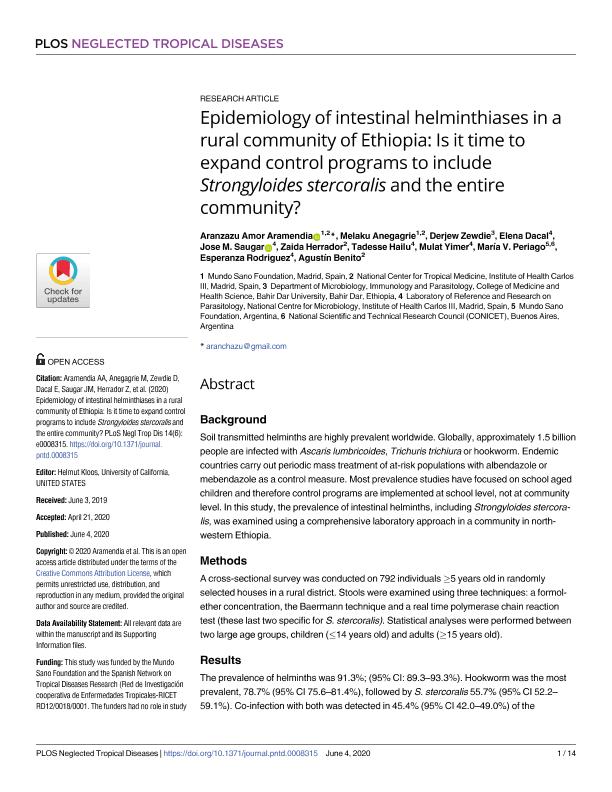Mostrar el registro sencillo del ítem
dc.contributor.author
Amor Aramendia, Aranzazu
dc.contributor.author
Anegagrie, Melaku
dc.contributor.author
Zewdie, Derjew
dc.contributor.author
Dacal, Elena
dc.contributor.author
Saugar, Jose M.
dc.contributor.author
Herrador, Zaida
dc.contributor.author
Hailu, Tadesse
dc.contributor.author
Yimer, Mulat
dc.contributor.author
Periago, Maria Victoria

dc.contributor.author
Rodriguez, Esperanza
dc.contributor.author
Benito, Agustín
dc.date.available
2022-09-21T19:29:06Z
dc.date.issued
2020-06
dc.identifier.citation
Amor Aramendia, Aranzazu; Anegagrie, Melaku; Zewdie, Derjew; Dacal, Elena; Saugar, Jose M.; et al.; Epidemiology of intestinal helminthiases in a rural community of Ethiopia: Is it time to expand control programs to include strongyloides stercoralis and the entire community?; Public Library of Science; Neglected Tropical Diseases; 14; 6; 6-2020; 1-14
dc.identifier.issn
1935-2735
dc.identifier.uri
http://hdl.handle.net/11336/169838
dc.description.abstract
Background: Soil transmitted helminths are highly prevalent worldwide. Globally, approximately 1.5 billion people are infected with Ascaris lumbricoides, Trichuris trichiura or hookworm. Endemic countries carry out periodic mass treatment of at-risk populations with albendazole or mebendazole as a control measure. Most prevalence studies have focused on school aged children and therefore control programs are implemented at school level, not at community level. In this study, the prevalence of intestinal helminths, including Strongyloides stercoralis, was examined using a comprehensive laboratory approach in a community in northwestern Ethiopia. Methods: A cross-sectional survey was conducted on 792 individuals ≥5 years old in randomly selected houses in a rural district. Stools were examined using three techniques: a formolether concentration, the Baermann technique and a real time polymerase chain reaction test (these last two specific for S. stercoralis). Statistical analyses were performed between two large age groups, children (≤14 years old) and adults (≥15 years old). Results: The prevalence of helminths was 91.3%; (95% CI: 89.3–93.3%). Hookworm was the most prevalent, 78.7% (95% CI 75.6–81.4%), followed by S. stercoralis 55.7% (95% CI 52.2– 59.1%). Co-infection with both was detected in 45.4% (95% CI 42.0–49.0%) of the participants. The mean age of hookworm-infected individuals was significantly higher than non-infected ones (p = 0.003). Also, S. stercoralis infection was significantly associated with age, being more prevalent in adults (p = 0.002). Conclusions: This is the highest prevalence of S. stercoralis detected in Ethiopia so far. Our results high-light the need of searching specifically for infection by this parasite since it usually goes unnoticed if helminth studies rely only on conventional diagnostic techniques, i.e. Kato-Katz.Moreover, the focus of these programs on children undermines the actual prevalence of hookworm. The adult population acts as a reservoir for both hookworm and S. stercoralis and this fact may negatively impact the current control programs in Ethiopia which only target treatment of school aged children. This reservoir, together with a lack of adequate water, sanitation and hygiene, increases the probability of re-infection in children. Finally, the high prevalence of S. stercoralis found calls for a comprehensive diagnostic approach in endemic areas in addition to a revision of control measures that is, adding ivermectin to current alben-dazole/mebendazole, since it is the drug of choice for S. stercoralis.
dc.format
application/pdf
dc.language.iso
eng
dc.publisher
Public Library of Science

dc.rights
info:eu-repo/semantics/openAccess
dc.rights.uri
https://creativecommons.org/licenses/by/2.5/ar/
dc.subject
SOIL-TRANSMITTED HELMINTHS
dc.subject
STRONGYLOIDES STERCORALIS
dc.subject
AMHARA
dc.subject
ETHIOPIA
dc.subject.classification
Otros Tópicos Biológicos

dc.subject.classification
Ciencias Biológicas

dc.subject.classification
CIENCIAS NATURALES Y EXACTAS

dc.title
Epidemiology of intestinal helminthiases in a rural community of Ethiopia: Is it time to expand control programs to include strongyloides stercoralis and the entire community?
dc.type
info:eu-repo/semantics/article
dc.type
info:ar-repo/semantics/artículo
dc.type
info:eu-repo/semantics/publishedVersion
dc.date.updated
2022-09-16T20:52:01Z
dc.journal.volume
14
dc.journal.number
6
dc.journal.pagination
1-14
dc.journal.pais
Estados Unidos

dc.journal.ciudad
San Francisco
dc.description.fil
Fil: Amor Aramendia, Aranzazu. Fundación Mundo Sano; Argentina. Instituto de Salud Carlos III; España
dc.description.fil
Fil: Anegagrie, Melaku. Fundación Mundo Sano; Argentina. Instituto de Salud Carlos III; España
dc.description.fil
Fil: Zewdie, Derjew. Bahir Dar University; Etiopía
dc.description.fil
Fil: Dacal, Elena. Instituto de Salud Carlos III; España
dc.description.fil
Fil: Saugar, Jose M.. Instituto de Salud Carlos III; España
dc.description.fil
Fil: Herrador, Zaida. Instituto de Salud Carlos III; España
dc.description.fil
Fil: Hailu, Tadesse. Instituto de Salud Carlos III; España
dc.description.fil
Fil: Yimer, Mulat. Instituto de Salud Carlos III; España
dc.description.fil
Fil: Periago, Maria Victoria. Consejo Nacional de Investigaciones Científicas y Técnicas; Argentina. Fundación Mundo Sano; Argentina
dc.description.fil
Fil: Rodriguez, Esperanza. Instituto de Salud Carlos III; España
dc.description.fil
Fil: Benito, Agustín. Instituto de Salud Carlos III; España
dc.journal.title
Neglected Tropical Diseases

dc.relation.alternativeid
info:eu-repo/semantics/altIdentifier/url/https://journals.plos.org/plosntds/article?id=10.1371/journal.pntd.0008315
dc.relation.alternativeid
info:eu-repo/semantics/altIdentifier/doi/http://dx.doi.org/10.1371/journal.pntd.0008315
Archivos asociados
